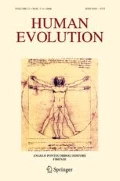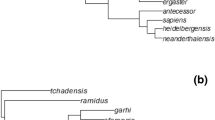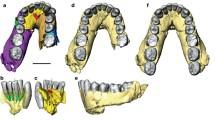Abstract
We present an analysis of cranial capacity of 118 hominid crania available from the literature. The crania belong to both the genusAustralopithecus andHomo and provide a clear outline of hominid cranial evolution starting at more than 3 million years ago. Beginning withA. afarensis there is a clear increase in both absolute and relative brain size with every successive time period.H.s. neandertal has an absolutely and relatively smaller brain size (1412cc, E.Q.=5.6) than fossil modernH.s. sapiens (1487cc, E.Q.=5.9). Three evolutionary models of hominid brain evolution were tested: gradualism, punctuated equilibrium, and a mixed model using both gradualism and punctuated equilibrium. Both parametric and non-parametric analyses show a clear trend toward increasing brain size withH. erectus and a possible relationship within archaicH. sapiens. An evolutionary stasis in cranial capacity could not be refuted for all other taxa. Consequently, the mixed model appears to more fully explain hominid cranial capacity evolution. However, taxonomic decisions could directly compromise the possibility of testing the evolutionary mechanisms hypothesized to be operating in hominid brain expansion.
Similar content being viewed by others
References
Arsuaga J.L., Martinez, I., Gracia, A., Carretero, J.M., & Carbonell, E., 1993. Three new human skulls from the Sima de los Huesos Middle Pleistocene site in Sierra de Atapuerca, Spain.Nature, 362: 534–537.
Beals K.L., Smith C.L. & Dodd S.M., 1984. Brain size, cranial morphology, climate, and time machines.Current Anthropology 25: 301–330.
Blumenberg B., 1983. The evolution of the advanced hominid brain.Current Anthropology 24: 589–623.
Bräuer G., 1989. The evolution of modern humans: a comparison of the African and non African evidence. In Mellars P. & Stringer C. (eds), 1989.The human revolution, Edinburgh: Edinburgh University Press, pp 123–154.
Bunney S., 1986. Did neanderthal babies have bigger brains than ours?New Scientist 110: 28–30.
Clark G.A. & Lindly J.M., 1989. The case of continuity: observations on the biocultural transition in Europe and Western Asia. In Mellars P. & Stringer C. (eds), 1989.The human revolution. Edinburgh: Edinburgh University Press, 123–154.
Clark J.D., 1989. The origins and spread of modern humans: a broad perspective on the African evidence. In Mellars P. & Stringer C. (eds) 1989.The human revolution. Edinburgh: Edinburgh University Press, pp. 565–588.
Cronin J.E., Boaz N.T., Stringer C.B. & Rak Y., 1981. Tempo and mode in hominid evolution.Nature 292: 115–122.
Darwin 1871.The descent of man. London: J. Murray.
Dubois E., 1898. Remarks upon the brain cast ofPithecanthropus erectus. Proc. IVth Int. Congr. Zool. Cambridge, pp. 85–86.
Eldredge N. & Gould S.J., 1972. Punctuated equilibria: an alternative to phyletic gradualism. In Schopf T.J.M. (ed),Models in paleobiology, San Francisco: Freeman, Cooper and Co., pp. 82–115.
Falk D., 1985. Hadar AL 162-28 endocast as evidence that brain enlargement preceded cortical reorganization in hominid evolution.Nature 313: 45–47.
Falk D., 1987a. Brain lateralization in primates and its evolution in hominids.Yearbook of Physical Anthropology 30: 107–125.
Falk, D. & S. Kasinga, 1983. Cranial capacity of a female robust australopithecinie (KNM-ER 407) from Kenya.J. Hum. Evol. 12: 515–518.
Gambier D., 1989. Fossil hominids from the early Upper Palaeolithic (Aurignacian) of France. In Mellars P. & Stringer C. (eds), 1989.The human revolution. Edinburgh: Edinburgh University Press, 194–211.
Godfrey and Jacobs, 1981. Gradulism, autocatalytic and punctuational models of hominid brain evolution: a cautionary tale.J. Human Evol. 10: 255–272.
Gould, 1981.The mismeasure of man. New York WW Norton.
Groves C.P., 1989.A theory of human and primate evolution. Oxford University Press, Oxford.
Habgood P.J., 1989a. An investigation into the usefulness of a cladistic approach to the study of the origin of anatomically modern humans.Hum. Evol. 4: 241–252.
Habgood P.J., 1989b. The origin of anatomically-modern humans in Australia. In Mellars P. & Stringer C. (eds). 1989. The human revolution. Edinburgh: Edinburgh University Press, pp. 245–273.
Henneberg M., 1987. Hominid cranial capacity change through time: a darwinian process.Hum. Evol. 2: 213–220.
Henneberg, M., 1989. Morphological and geological dating of early hominid fossils compared. Current Anthropol. 30: 527–29.
Holloway R.L., 1988b. Brain. In Tattersal I., Delson E. & Van Couvering J. (eds), 1988.Encyclopedia of Hum. Evol. and prehistory. New York: Garland Publishing, Tattersal et al. (eds), pp. 98–105.
Holloway R.L., 1975. Early hominid endocast: volumes, morphology and significance in hominid evolution. In Tuttle, R.H. (ed.)Primate functional morphology and evolution, L'Aja: Mouton, pp. 393–415.
Holloway R.L., 1978. Problems of brain endocast interpretation and African hominid evolution. In Jolly C.J. (ed),Early hominids of Africa, New York: St. Martin's Press, pp. 379–401.
Holloway R.L., 1980a. The OH 7 (Olduvai Gorge, Tanzania) hominid partial brain endocast revisited.Am. J. Phy. Anthro. 53: 267–274.
Holloway R.L., 1980b. Indonesian “Solo” (Ngadong) endocranial reconstructions: some preliminary observations and comparisons with neandertal andHomo erectus groups.Am. J. Phys. Anthro. 53: 285–295.
Holloway R.L., 1981a. The indonesianHomo erectus brain endocasts revisited. Am. J. Phy. Anthro. 55: 503–521.
Holloway R.L., 1981b. Volumetric and assymetry determinations on recent hominid endocasts: Spy I and II, Djebel Ihroud and the SaléHomo erectus specimens, with some notes on neandertal brain size.Am. J. Phy. Anthro., 55: 385–393.
Holloway R.L., 1983. Cerebral brain endocast ofAustralopithecus afarensis.Nature 303: 420–422.
Holloway R.L. 1985. The poor brain ofHomo sapiens neanderthalensis: see what you please. In Ancestors: The hard evidence pp 319–324.
Jerison H.J., 1973.Evolution of the brain and intelligence. New York, London: Academic Press.
Jungers W.L., 1988. Lucy's length: stature recontruction inAustralopithecus afarensis (A.L.288-1) with implications for other small bodied hominids. Am. J. Phy. Anthro. 76: 227–232.
Klein R.G., 1989 a.The human career: human biological and cultural origins. Chicago and London: University of Chicago Press.
Leakey R.E.F. & Walker A., 1988. NewAustralopithecus boisei specimens from East and West Lake Turkana, Kenya.Am. J. Phy. Anthro. 76: 1–24.
Leakey L.S.B., Tobias, P.V. & J.R. Napier, 1964. A new species of the genusHomo from the Olduvai GorgeNature 202.
Leigh S.R., 1992. Cranial capacity evolution inHomo erectus and earlyHomo sapiens.Am. J. Phy. Anthro. 87: 1–13.
Lynn R., 1990. The evolution of brain size and intelligence in man.Hum. Evol. 5: 241–244.
Martin, 1990. Primate origins and evolution:A phylogenetic reconstruction. London, Chapman and Hall.
McCown T.D. & Keith, 1939.The stone age of Monte Carmel, vol. 2. The fossil human remains from the Levalloiso-Mousterian. Oxford: The Clarendon Press (cit. in Miller 1991).
McHenry H.M., 1991a. Femoral lengths and stature in Plio-Pleistocene hominids.Am. J. Phy. Anthro. 85:149–158.
McHenry H.M., 1991b. Petite bodies of the “robust” australopithecines.Am. J. Phys. Anthro. 86: 445–454.
McHenry H.M., 1992a. Body size and proportions in early hominids.Am. J. Phys. Anthro. 87: 407–431.
McHenry H.M., 1992b. How big were early hominids?,Evolutionary Anthropology 1: 15–20.
Miller J.A., 1991. Does brain size variability provide evidence of multiple species inHomo habilis? Am. J. Phys. Anthro. 84: 385–398.
Pope G.G., 1988. Sambungmachan. In Tattersal I., Delson E. & Van Couvering J. (eds), 1988. Encyclopedia of Hum. Evol. and prehistory. New York: Garland Publishing, pp. 503.
Rightmire P.G., 1990. The evolution ofHomo erectus. Cambridge: Cambridge University Press.
Sergi S., 1948. The palaeanthropi in Italy: the fossil men of Saccopastore and Circeo. Man 48: 61–79 (cit. in Miller 1991).
Stringer C.B., 1986. The credibility ofHomo habilis. In Wood B., Martin L. & Andrews P. (eds),Major topics in primate and Hum. Evol., Cambridge: Cambridge University Press, pp.266–294.
Stringer C.B., 1989a. Documenting the origins of modern humans. In Trinkaus E. (ed), 1989 a, pp.67–96.
Stringer C.B., 1989b. The origin of early modern humans: a comparison of the European and non-European evidence. In Mellars P. & Stringer C. (eds), 1989.The human revolution. Edinburgh: Edinburgh University Press.
Suzuki H. & Takai F., 1970. The Amud man and his cave site. Tokyo: Keigaku Publishing Co. (cit. in Miller 1991).
Tobias P.V. 1964. The Olduvai bed I hominine with special reference to brain and speech.Pontificiae Acad. Scient. Scripta Varia 50: 85–140.
Tobias P.V., 1971. The brain in hominid evolution. New York: Columbia University Press.
Tobias, P.V., 1983.Recent advances in the evolution of the Hominids with special reference to brain and speech Pontificiae Academiae Scientiarum Scripta Varia 50:85–140.
Tobias, P.V., 1987. The brain ofHomo habilis: a new level of organization in cerebral evolution.J. Hum. Evol. 16: 741–761.
Trinkaus E., 1990. Cladistic and the hominid fossil record.Am. J. Phys. Anthro. 83: 1–11.
Trinkaus E., 1989. Issues concerning human emergence in the later Pleistocene. In Trinkaus (ed) 1989.The emergence of modern humans. Cambridge: Cambridge University Press. pp. 1–17.
Valladas H., Joron J.L., Valladas, G., Arensburg B., Bar-Yosef C., Belfer-Cohen A., Goldberg P., Laville H., Meignen L., Rak Y., Tchernov E., Tillier A.-M. & Vandermeersch B., 1987. Thermoluminescence dates for the Neanderthal burial site at Kebara in Israel.Nature 330: 159–160.
Vandermeersch B., 1989. The evolution of modern humans: recente evidence from Southwest Asia. In Mellars P. & Stringer C. (eds), 1989a.The human revolution. Edinburgh: Edinburgh University Press, pp. 155–164.
Vleck E., 1955. The fossil man of Gànovce, Czechoslovachia.J. R. Anthropol. Inst. 85: 163–171 (cit. in Miller 1991).
Weidenreich F., 1943. The skull ofSinanthropus pekinensis: a comparative study on a primitive hominid skull. Palaentologica Sinica, new ser. D., n. 10, whole series 127: 1–484 (cit. in Miller 1991).
Williams B.J., 1987. Is there a conflict between neo-darwinian evolutionary theory and the fossil record?Am. J. Phy. Anthro. 73: 99–109.
Wolpoff M.H., 1980. Cranial remains of Middle Pleistocene European hominids.J. Hum. Evol. 9: 339–358.
Woo J.K., 1966. The skull of Lantian man.Curr. Anthro. 7: 83–86.
Wood B., 1992. Origin and evolution of the genusHomo.Nature 355: 783–790.
Wu R. & Dong X., 1982. Preliminary study ofHomo erectus remains from Hexian, Hanui.Acta Anthropol. Sin. 1: 2–13 (cit. in Miller 1991).
Author information
Authors and Affiliations
Rights and permissions
About this article
Cite this article
Stanyon, R., Consigliere, S. & Morescalchi, M.A. Cranial capacity in hominid evolution. Hum. Evol. 8, 205–216 (1993). https://doi.org/10.1007/BF02436715
Received:
Accepted:
Issue Date:
DOI: https://doi.org/10.1007/BF02436715




